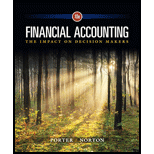
Concept explainers
1.
Introduction:
To identify and prepare:Adjustment entry.
2.
Introduction: Journal entry is recorded for each transaction that has been incurred during the accounting period wherein one or more accounts are debited or credited and the total of both debit and credit equals.
To compute:The amount of prepaid rent paid on April 1 2016.
3.
Introduction: Journal entry is recorded for each transaction that has been incurred during the accounting period wherein one or more accounts are debited or credited and the total of both debit and credit equals.
To identify and prepare:Adjustment entry to record
4.
Introduction: Journal entry is recorded for each transaction that has been incurred during the accounting period wherein one or more accounts are debited or credited and the total of both debit and credit equals.
To compute:Useful life of equipment.
5.
Introduction: Journal entry is recorded for each transaction that has been incurred during the accounting period wherein one or more accounts are debited or credited and the total of both debit and credit equals.
To identify and prepare:Adjustment entry for interest expense.
6.
Introduction: Journal entry is recorded for each transaction that has been incurred during the accounting period wherein one or more accounts are debited or credited and the total of both debit and credit equals.
To compute:Monthly interest rate on the loan.
Want to see the full answer?
Check out a sample textbook solution
Chapter 4 Solutions
Financial Accounting: The Impact on Decision Makers
 Financial Accounting: The Impact on Decision Make...AccountingISBN:9781305654174Author:Gary A. Porter, Curtis L. NortonPublisher:Cengage LearningCentury 21 Accounting Multicolumn JournalAccountingISBN:9781337679503Author:GilbertsonPublisher:Cengage
Financial Accounting: The Impact on Decision Make...AccountingISBN:9781305654174Author:Gary A. Porter, Curtis L. NortonPublisher:Cengage LearningCentury 21 Accounting Multicolumn JournalAccountingISBN:9781337679503Author:GilbertsonPublisher:Cengage Financial AccountingAccountingISBN:9781337272124Author:Carl Warren, James M. Reeve, Jonathan DuchacPublisher:Cengage Learning
Financial AccountingAccountingISBN:9781337272124Author:Carl Warren, James M. Reeve, Jonathan DuchacPublisher:Cengage Learning Intermediate Accounting: Reporting And AnalysisAccountingISBN:9781337788281Author:James M. Wahlen, Jefferson P. Jones, Donald PagachPublisher:Cengage Learning
Intermediate Accounting: Reporting And AnalysisAccountingISBN:9781337788281Author:James M. Wahlen, Jefferson P. Jones, Donald PagachPublisher:Cengage Learning College Accounting, Chapters 1-27AccountingISBN:9781337794756Author:HEINTZ, James A.Publisher:Cengage Learning,
College Accounting, Chapters 1-27AccountingISBN:9781337794756Author:HEINTZ, James A.Publisher:Cengage Learning,





